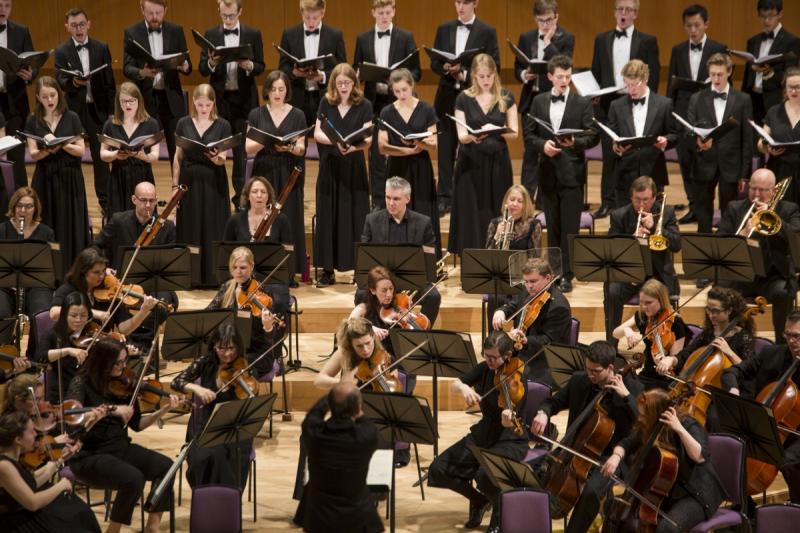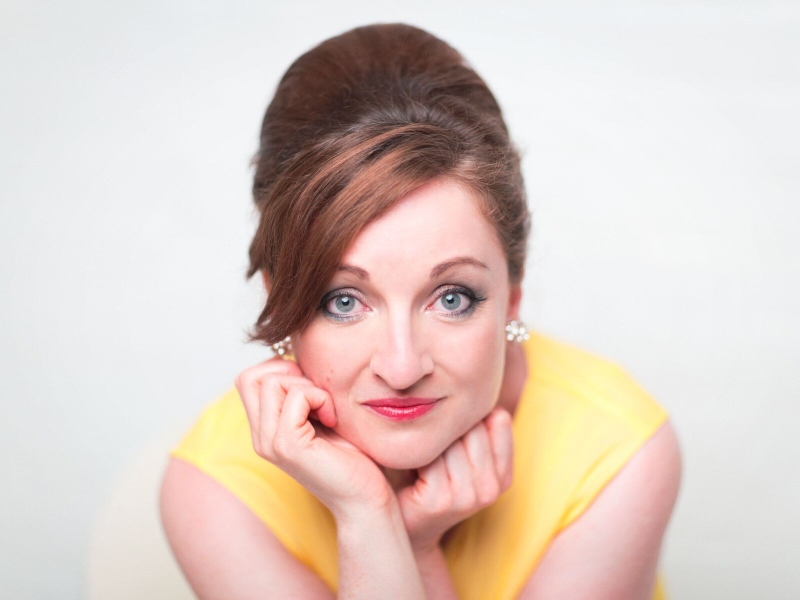Clare College Choir, Manchester Camerata, Takács-Nagy, Bridgewater Hall, Manchester review – romance and drama | reviews, news & interviews
Clare College Choir, Manchester Camerata, Takács-Nagy, Bridgewater Hall, Manchester review – romance and drama
Clare College Choir, Manchester Camerata, Takács-Nagy, Bridgewater Hall, Manchester review – romance and drama
Pace is everything in an expressive Mozart Requiem

It began in semi-darkness. Appropriate for Arvo Pärt, perhaps – after all, Manchester Camerata have played his music in Manchester Cathedral to great atmospheric effect in the past. But the Choir of Clare College Cambridge, conducted by Graham Ross, delivered his Da pacem Domine in a hall where it seemed as if the lights had failed … not quite the same thing.
They sang the brief, four-part, a cappella piece fairly accurately and, for the most part, confidently, but the 26 young singers could not create the spark, or the richness of tone, that might have brought its holy minimalism to real life.
And they were already walking off the platform when the lights came on. It was almost like a pre-concert event, for the next procedure was the arrival (applauded) of the Camerata musicians to play their Mozart symphony.
Gábor Takács-Nagy likes to talk to audiences before conducting his orchestra, and he explained his theory of the story behind the opening of Mozart’s Symphony no. 36 (the ‘Linz’). Wolfgang and Constanze have just tried, and failed, to forge a good relationship with daddy Leopold in Salzburg – they arrive with relief at Linz, and the slow introduction depicts grumpy father, beautiful sweetheart, sad goodbye and then … on to a jolly time in pleasant surroundings.
It’s a Romantic notion, but Takács-Nagy is a bit of a Romantic at heart. The symphony is a serenade in all but name, with a quasi-operatic introduction, and he loves its delicate emotions and its liveliness. The Camerata – a bit stronger in numbers than the ensemble we meet in smaller venues, with five celli and three bassi, and led by Caroline Pether – sounded slightly ragged in ensemble in the slower sections, but they picked up on their conductor’s intimations in the ‘sensibility’ style of the second movement, and the presto finale gave them no problems. He was audibly singing along to the music much of the time, and when he tried to introduce some variety of articulation to the minuet and trio it wasn’t entirely clear what they had been expecting. That’s where spontaneity can let you down, especially with players who aren’t regularly accustomed to it.
 The meat of the evening was Mozart’s Requiem, with soloists Ailish Tynan (pictured left), Anna Harvey, Nicholas Mulroy and Peter Harvey (a well-balanced team) and the Clare College Choir. Takács-Nagy was going for drama in the work, asking his chorus for growing and shrinking weight of tone here and there, to which they responded well, although too small in number to create the big impact he may have hoped for at its peaks. But pace was everything: his vigorous Kyrie demanded mercy rather than pleading for it, with excellent clarity in the choral counterpoint.
The meat of the evening was Mozart’s Requiem, with soloists Ailish Tynan (pictured left), Anna Harvey, Nicholas Mulroy and Peter Harvey (a well-balanced team) and the Clare College Choir. Takács-Nagy was going for drama in the work, asking his chorus for growing and shrinking weight of tone here and there, to which they responded well, although too small in number to create the big impact he may have hoped for at its peaks. But pace was everything: his vigorous Kyrie demanded mercy rather than pleading for it, with excellent clarity in the choral counterpoint.
Partly as a result of that, the Dies Irae – also fast, and intently furious – had less impact than might have been. But the Tuba mirum revealed the sterling qualities of the solo quartet, even if the style was operatic more in the manner of The Magic Flute than La Clemenza di Tito, and the Rex tremendae brought vehemence and plaintiveness in equal measure from the chorus (as did the Confutatis later).
The four soli were wondrous in the Recordare – Ailish Tynan lyrical and soaring over the texture, Nicholas Mulroy passionate and powerful, and Anna Harvey and Peter Harvey adding well judged contributions – and the choral singing in the Lacrimosa was one of the best parts of the whole performance.
Domine Jesus was particularly fast for an Andante, as if Takács-Nagy thought the solution for most issues was to speed along, and the first run at the Osanna fugue (after the Sanctus) left the chorus lagging a little behind the beat – but the second go was much better.
Once arrived in Süssmayr territory, it was as if the conductor could not quite lavish the expressive qualities on the music that he had found in that of his beloved Mozart (few conductors can), but the Benedictus and Agnus Dei achieved the requisite degree of liturgical piety and were warmly sung and played. And finally back with the master, the Lux aeterna and Cum sanctis fugue were confident, lively and brought an impressive and much appreciated ending to the work.
rating
Explore topics
Share this article
The future of Arts Journalism
You can stop theartsdesk.com closing!
We urgently need financing to survive. Our fundraising drive has thus far raised £49,000 but we need to reach £100,000 or we will be forced to close. Please contribute here: https://gofund.me/c3f6033d
And if you can forward this information to anyone who might assist, we’d be grateful.

Subscribe to theartsdesk.com
Thank you for continuing to read our work on theartsdesk.com. For unlimited access to every article in its entirety, including our archive of more than 15,000 pieces, we're asking for £5 per month or £40 per year. We feel it's a very good deal, and hope you do too.
To take a subscription now simply click here.
And if you're looking for that extra gift for a friend or family member, why not treat them to a theartsdesk.com gift subscription?
more Classical music
 Bizet in 150th anniversary year: rich and rare French offerings from Palazzetto Bru Zane
Specialists in French romantic music unveil a treasure trove both live and on disc
Bizet in 150th anniversary year: rich and rare French offerings from Palazzetto Bru Zane
Specialists in French romantic music unveil a treasure trove both live and on disc
 Scottish Chamber Orchestra, Ibragimova, Queen’s Hall, Edinburgh review - rarities, novelties and drumrolls
A pity the SCO didn't pick a better showcase for a shining guest artist
Scottish Chamber Orchestra, Ibragimova, Queen’s Hall, Edinburgh review - rarities, novelties and drumrolls
A pity the SCO didn't pick a better showcase for a shining guest artist
 Kilsby, Parkes, Sinfonia of London, Wilson, Barbican review - string things zing and sing in expert hands
British masterpieces for strings plus other-worldly tenor and horn - and a muscular rarity
Kilsby, Parkes, Sinfonia of London, Wilson, Barbican review - string things zing and sing in expert hands
British masterpieces for strings plus other-worldly tenor and horn - and a muscular rarity
 From Historical to Hip-Hop, Classically Black Music Festival, Kings Place review - a cluster of impressive stars for the future
From quasi-Mozartian elegance to the gritty humour of a kitchen inspection
From Historical to Hip-Hop, Classically Black Music Festival, Kings Place review - a cluster of impressive stars for the future
From quasi-Mozartian elegance to the gritty humour of a kitchen inspection
 Shibe, LSO, Adès, Barbican review - gaudy and glorious new music alongside serene Sibelius
Adès’s passion makes persuasive case for the music he loves, both new and old
Shibe, LSO, Adès, Barbican review - gaudy and glorious new music alongside serene Sibelius
Adès’s passion makes persuasive case for the music he loves, both new and old
 Anja Mittermüller, Richard Fu, Wigmore Hall review - a glorious hall debut
The Austrian mezzo shines - at the age of 22
Anja Mittermüller, Richard Fu, Wigmore Hall review - a glorious hall debut
The Austrian mezzo shines - at the age of 22
 First Person: clarinettist Oliver Pashley on the new horizons of The Hermes Experiment's latest album
Compositions by members of this unusual quartet feature for the first time
First Person: clarinettist Oliver Pashley on the new horizons of The Hermes Experiment's latest album
Compositions by members of this unusual quartet feature for the first time
 Gesualdo Passione, Les Arts Florissants, Amala Dior Company, Barbican review - inspired collaboration excavates the music's humanity
At times it was like watching an anarchic religious procession
Gesualdo Passione, Les Arts Florissants, Amala Dior Company, Barbican review - inspired collaboration excavates the music's humanity
At times it was like watching an anarchic religious procession
 Classical CDs: Camels, concrete and cabaret
An influential American composer's 90th birthday box, plus British piano concertos and a father-and-son duo
Classical CDs: Camels, concrete and cabaret
An influential American composer's 90th birthday box, plus British piano concertos and a father-and-son duo
 Cockerham, Manchester Camerata, Sheen, Martin Harris Centre, Manchester review - re-enacting the dawn of modernism
Two UK premieres added to three miniatures from a seminal event of January 1914
Cockerham, Manchester Camerata, Sheen, Martin Harris Centre, Manchester review - re-enacting the dawn of modernism
Two UK premieres added to three miniatures from a seminal event of January 1914
 Kempf, Brno Philharmonic, Davies, Bridgewater Hall, Manchester review - European tradition meets American jazz
Bouncing Czechs enjoy their Gershwin and Brubeck alongside Janáček and Dvořák
Kempf, Brno Philharmonic, Davies, Bridgewater Hall, Manchester review - European tradition meets American jazz
Bouncing Czechs enjoy their Gershwin and Brubeck alongside Janáček and Dvořák
 Solomon, OAE, Butt, QEH review - daft Biblical whitewashing with great choruses
Even a top soprano and mezzo can’t make this Handel paean wholly convincing
Solomon, OAE, Butt, QEH review - daft Biblical whitewashing with great choruses
Even a top soprano and mezzo can’t make this Handel paean wholly convincing

Add comment